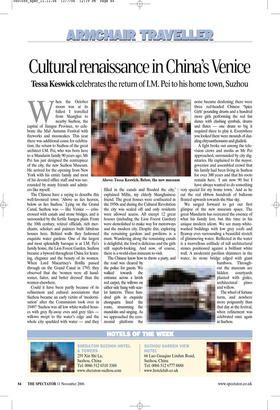Cultural renaissance in China’s Venice
Tessa Keswick celebrates the return of I.M. Pei to his home town, Suzhou When the October moon was at its fullest I travelled from Shanghai to nearby Suzhou, the capital of Jiangsu Province, to celebrate the Mid Autumn Festival with fireworks and mooncakes. This year there was additional cause for celebration; the return to Suzhou of the great architect I.M. Pei, who was born here to a Mandarin family 90 years ago. Mr Pei has just designed the centrepiece of the city, the new Suzhou Museum. He arrived for the opening from New York with his entire family and most of his devoted office staff and was surrounded by many friends and admirers like myself.
The Chinese have a saying to describe this well-favoured town: ‘Above us lies heaven, below us lies Suzhou.’ Lying on the Grand Canal, Suzhou was — like Venice — crisscrossed with canals and stone bridges, and is surrounded by the fertile Jiangsu plain. From the 10th century, retired officials, rich merchants, scholars and painters built fabulous houses here. Behind walls they fashioned exquisite water gardens. One of the largest and most splendidly baroque is at I.M. Pei’s family home, the Lion Forest Garden. Suzhou became a byword throughout China for learning, elegance and the beauty of its women. When Lord Macartney’s flotilla passed through on the Grand Canal in 1793, they observed that the ‘women were all handsomer, fairer, and better dressed’ than the women elsewhere.
Could it have been partly because of its refinement and cultural associations that Suzhou became an early victim of ‘modernisation’ after the Communists took over in 1949? ‘Suzhou was all low white-walled houses with grey fly-away eves and grey tiles willows swept to the water’s edge and the whole city sparkled with water — and they filled in the canals and flooded the city,’ explained Millie, my elderly Shanghainese friend. The great houses were confiscated in the 1950s and during the Cultural Revolution the city was sealed off and only residents were allowed access. All except 12 great houses (including the Lion Forest Garden) were demolished to make way for motorways and the modern city. Despite this, exploring the remaining gardens and pavilions is a must. Wandering along the remaining canals is delightful, the food is delicious and the girls still superb-looking. And now, of course, there is a world-class museum to visit.
The Chinese know how to throw a party, and the road was cleared by the police for guests. We walked towards the entrance across a lavish red carpet, the willows on either side hung with scarlet lanterns. Three hundred girls in exquisite chongsams lined the route, strumming the mandolin and singing. As we approached the ceremonial platform the noise became deafening; there were three red-headed Chinese ‘Spice Girls’ pounding drums and a hundred more girls performing the red fan dance with clashing cymbals, drums and flutes — one drum so big it required three to play it. Everywhere you looked there were mounds of dazzling chrysanthemums and gladioli.
A fight broke out among the television crews and media as Mr Pei approached, surrounded by city dignitaries. He explained to the mayor, governor and assembled crowd that his family had been living in Suzhou for over 300 years and that his roots remain here. ‘I am now 90 but I have always wanted to do something very special for my home town.’ And as he cut the red ribbon hundreds of balloons floated upwards towards the blue sky.
We surged forward to get our first glimpse of the new museum space. The great Mandarin has recreated the essence of what his family lost, but this time in his unique modern idiom. We see many whitewashed buildings with low grey roofs and flyaway eves surrounding a beautiful stretch of glimmering water. Reflected in the water is a marvellous enfilade of tall architectural stones positioned against a brilliant white wall. A modernist pavilion shimmers in the water, its stone bridge edged with giant bamboos. Throughout the museum are hidden courtyards planted with ginko, architectural pines and willow.
The wheel of fortune turns, and nowhere more poignantly than that day at the festival, when refinement was celebrated once again in Suzhou.


































































































 Previous page
Previous page